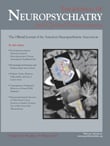Dissimilar Neuropsychiatric Presentations of Two Siblings With Juvenile Neuronal Ceroid Lipofuscinosis (Batten Disease)
To the Editor: Juvenile neuronal ceroid lipofuscinosis, also known as Batten disease, is a neuropsychiatric disorder in childhood and adolescence characterized by progressive visual loss, impaired cognitive and motor function, and seizures, leading to early demise. 1 Besides cognitive impairment, other psychiatric symptoms have not been as well described. 2 , 3 Moreover, intrafamilial or sibling pairs have not been specifically studied. Here we report a pair of siblings with juvenile neuronal ceroid lipofuscinosis who presented to a psychiatric clinic with significantly different neuropsychiatric symptoms.
Case Report
Two siblings from a consanguineous marriage were diagnosed clinically and histopathologically with juvenile neuronal ceroid lipofuscinosis. There were two other younger siblings in the family in their early teens who were apparently unaffected, and nobody else in the extended family had the disease. The elder of the two was a 20-year-old woman, who started having visual loss at age 6. She developed progressive difficulty in walking and has since become wheelchair-bound. Around the age of 16, she developed generalized tonic-clonic seizures that were poorly controlled. She also became depressed and emotionally labile and reported having auditory hallucinations and paranoid delusions. She is severely cognitively impaired and unable to care for herself. The younger sibling is an 18-year-old man who started visual deterioration at age 7. He developed some motor difficulties but at present is still able to walk with a mild ataxic gait and with guidance since losing sight. He has not had any seizures to date, and he has been able to perform most activities of daily living. He did not endorse any mood or psychotic symptoms currently or in the past, and this was corroborated by his family. However, he too was severely cognitively impaired and did have intermittent explosive tantrums, undirected aggressiveness, and social inappropriateness (e.g., shouting at strangers).
We attempted to optimize the antiseizure, antidepressant, and antipsychotic medications for the older sibling. For the younger sibling, we started risperidone, 0.5 mg twice a day, to help manage his intermittent behavioral dyscontrol while being mindful that risperidone at higher doses might exacerbate the motor symptoms. We also offered supportive psychotherapy and recommended physical and occupational therapy. For the younger sibling with aggressive symptoms, we referred him to a psychologist for behavioral treatment strategies (e.g., deceleration techniques and contingent observation). 4 For the parents and family members, we offered psychoeducation and support.
Discussion
Juvenile neuronal ceroid lipofuscinosis is an autosomal-recessive inherited disorder with the identified mutation at the CLN3 gene on chromosome 16p12.1. 1 , 5 CLN3 encodes a hydrophobic transmembrane protein whose functions have not yet been fully elucidated. CLN3P has been postulated to have possible roles in maintaining intracellular pH homeostasis, transport and channel functioning, and regulating vesicular transport. The loss of function ultimately leads to a build-up of lipofuscins (lipopigments) in the body’s tissues and to severe neuronal loss that would account for the neuropsychiatric symptoms.
Differences in the phenotypic presentation of juvenile neuronal ceroid lipofuscinosis between unrelated subjects could be due to the large number of variants. For CLN3 alone, there are 41 mutations and five polymorphisms reported as of July 26, 2008. 6
Two affected siblings would have inherited the same mutation. But their neuropsychiatric presentations and impairment, to date, markedly differ. However, it is possible that the younger sibling may eventually develop other symptoms. The difference in presentation could be attributed to differences in age and sex. Bäckman et al. 3 reported that, in general, females had more psychiatric symptoms. However, Adams et al. 2 reported that males and females did not differ with regard to the number of behavioral problems. We hypothesize that part of the phenotypic difference could be accounted for by epigenetic processes that led to differential expression of the mutant genes and posttranslation modifications. Further study of sibling pairs with the same mutation may provide useful insights into epigenetic processes that lead to different phenotypic presentations.
1. Rakheja D, Narayan SB, Bennett MJ: Juvenile neuronal ceroid-lipofuscinosis (Batten disease): a brief review and update. Curr Mol Med 2007; 7:603–608Google Scholar
2. Adams HR, Kwon J, Marshall FJ, et al: Neuropsychological symptoms of juvenile-onset Batten disease: experiences from two studies. J Child Neurol 2007; 22:621–627Google Scholar
3. Bäckman ML, Santavuori PR, Aberg LE, et al: Psychiatric symptoms of children and adolescents with juvenile neuronal ceroid lipofuscinosis. J Intellect Disabil Res 2005; 49:25–32Google Scholar
4. Silver JM, Yudofsky SC, Anderson KG: Agitation and aggressive, in Guide to Neuropsychiatric Therapeutics. Edited by Coffey CE, McAllister TW, Silver JM. Philadelphia, Lippincott Williams & Wilkins, 2007, pp 371–387Google Scholar
5. Williams RE, Aberg L, Autti T, et al: Diagnosis of the neuronal ceroid lipofuscinoses: an update. Biochim Biophys Acta 2006; 1762:865–872Google Scholar
6. MRC Laboratory for Molecular Cell Biology: NCL resource: a gateway for Batten disease. Available at http://www.ucl.ac.uk/ncl/cln3Google Scholar



